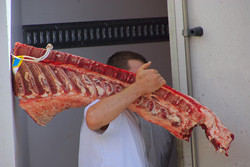Systemising meat production
The European meat industry needs to modernise and evolve. For that to happen, some argue, the industry must move to a demand-driven supply chain, while also introducing new safety technologies. The EU-funded QUARISMA (Quality and risk management in supply chains) project aimed to develop and introduce the necessary changes. The prime goal was raising quality, to be achieved through a techno-management approach to innovation and risk-control. Other goals included fostering knowledge transfer among industry players, and improving the effectiveness of research. The ambitions were achieved via secondments and other exchanges. The nine-member consortium ran for four years to August 2013. Work began with analysis of four German pork enterprises that successfully implemented supply-chain systems. The study highlighted how general introduction of such systems led to improvement. Related work compared pig health management systems in three countries, yielding suggestions for harmonisation of the systems. QUARISMA also developed a decision-support tool to establish cost-effective ways of monitoring dioxins throughout supply-chains, concluding that feed mills were the most effective detection point. The consortium examined the potential for IT support of quality management. Using classical swine fever as an example of a potential crisis, the team adapted a general Engage-Exchange model into an industry-specific prototype model. The model supported public-private alliances and helped improve crisis communications. A further innovation involved assessing herd health through blood analysis. The resulting serological indicator helped with quality-control decisions, and was implemented by a German growers' association. Other developments included demonstration of a microbiological concept to improve hazard control and reduce risks along the supply chain. The team incorporated a farm health management system intended to identify herds suffering sub-par health. The project developed a training programme, accredited by German authorities, intended to restructure and modernise European university courses in the subject. Finally, the project published German and English versions of a book of its outcomes. QUARISMA fostered effective partnerships among players in the European meat production industry. The work yielded systems for managing supply-chains, meaning higher quality meats.
Keywords
Meat, demand-driven, supply chain, safety, management



